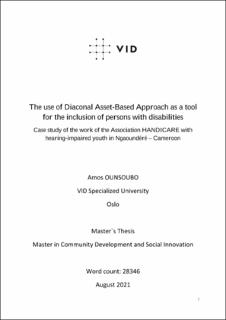| dc.description.abstract | The inclusion of groups in situation of marginalisation such as people with disabilities (PwD) is one of the great challenges that the ‘Leave No behind’ approach of the SDGs aims to solve. Very often, organisations and academic research address the issue of inclusion of PwD from the perspective of their vulnerability, overlooking their strength. The objective of this study is to look at the matter from the opposite side, meaning starting from the abilities, competences, and skills of PwD by assessing whether the approach used by HANDICARE (an association with a Christian background in Ngaoundere – Cameroon) in their work for the inclusion of the hearing-impaired youth is diaconal asset-based and can be used for the inclusion of other similar groups. One member of the staff of HANDICARE, ten hearing-impaired youth and tree parents participated then in semi-structured interviewed.
The diaconal Asset-Based Community Development (ABCD) approach ‘Use Your Talents’ (UYT) (the main concept) enriched by three other concepts (Seeking Conviviality - another diaconal ABCD, Empowerment and Social Innovation) constituted the conceptual framework which led the analysis. The concept of Disability-Inclusive Development also helped to identify the features of the inclusion in the perspective of HANDICARE. This study revealed that the method used by that association work has a diaconal character since it is carried out with the motivation of showing the love of Christ and is asset-based focusing their method on the assets and competence of the hearing-impaired youth. The HANDICARE approach presents the characteristics of UYT with additionally a good application of the twin-track approach. The effectiveness of the inclusive process is shown in how the hearing-impaired youth are less discriminated and feel more emancipated when their competences are expressed and recognised. The expression of their talents and skills gives them confidence to consider themselves as fully members of the community. The study also revealsthat diaconal asset-based methods like UYT in an integrated model with elements of Seeking Conviviality and Empowerment, especially the fight for the rights of groups in a situation of marginalisation, can effectively be used as a tool for the inclusion of PwD. | en_US |
